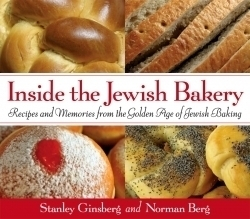
Inside the Jewish Bakery
Recipes and Memories from the Golden Age of Jewish Baking
There are few moments more satisfying than feeding family and friends with bread made from scratch. No mixes. No shortcuts. It is an ancient practice, enshrined in both the Old and New Testaments. So much more than a cookbook, Inside the Jewish Bakery, by Stanley Ginsberg and Norman Berg, is an offering to the memory of all those who have labored over the kneading board and withstood the heat of the oven to feed the body and nourish the spirit.
Stanley Ginsberg, a writer by trade, grew up in Brooklyn in the years after World War II and was intimately connected to the Jewish and Italian neighborhoods of that time and place. Norman Berg grew up in the Bronx and has worked as a baker in the New York City area for nearly a quarter of a century. The love and knowledge these two men have for the traditions and products of the traditional Jewish bakery are the soul of this book.
Inside the Jewish Bakery is divided into three basic parts. The first is a brief history, not just of bakery shops, but also of the experience of the Yiddish community in Europe and the United States. This background is fascinating and enlightening. The authors explain: “Z’chor, memory, lies at the heart of Jewish identity—memory of our liberation from slavery in Egypt, memory of the giving of the Torah and memory of those who have died. Memory is the essence of life, for as long as something or someone is remembered, they are eternal.”
The second, and largest part, contains recipes for all sorts of breads and pastries, from challah to sour cream spritz cookies. “These recipes are rooted in a time and specific place, and are actual production formulas used in actual bakeries, scaled down for home use.” Each recipe is given in volume, weight (both ounces and grams), and baker’s percentage (a method of expressing the amounts of ingredients as a percentage of the main ingredient, usually the flour). The recipes and the directions are clearly written, but the home baker needs to pay attention. The recipe for challah, for instance, calls for 7 ½ large egg yolks. The size of the egg yolks matters. Likewise, when weighing salt, the authors note table salt and kosher salt have different weights for the same volume.
The third section covers the techniques to be used in reproducing these delicacies. Again, Ginsberg and Berg are clear and precise. Not only are there detailed instructions on how to braid bread dough, for instance, there are pictures showing the various steps in the process. The book is sprinkled with pictures of finished baked goods. There is also a guide to “Troubleshooting Failed Cakes,” which is helpful to review before baking to avoid problems.
A home baker using Inside the Jewish Bakery will need to supply a generous portion of time and patience. The idea here is to bake quality breads, rolls, and sweet goods, not quick food or last-minute deserts. Quality takes time and patience, but the results are worth every every ounce of effort.
Reviewed by
John Michael Senger
Disclosure: This article is not an endorsement, but a review. The publisher of this book provided free copies of the book to have their book reviewed by a professional reviewer. No fee was paid by the publisher for this review. Foreword Reviews only recommends books that we love. Foreword Magazine, Inc. is disclosing this in accordance with the Federal Trade Commission’s 16 CFR, Part 255.
